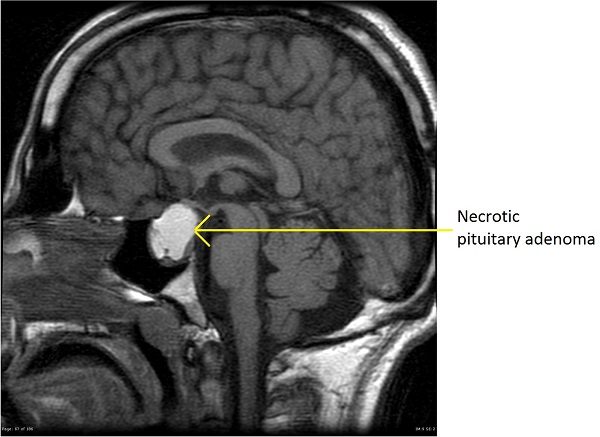Pituitary apoplexy MRI
Jump to navigation
Jump to search
|
Pituitary apoplexy Microchapters |
|
Diagnosis |
|---|
|
Treatment |
|
Case Studies |
|
Pituitary apoplexy MRI On the Web |
|
American Roentgen Ray Society Images of Pituitary apoplexy MRI |
|
Risk calculators and risk factors for Pituitary apoplexy MRI |
Editor-In-Chief: C. Michael Gibson, M.S., M.D. [1]; Associate Editor(s)-in-Chief: Akshun Kalia M.B.B.S.[2]
Overview
MRI is done if the CT scan is suspicious for pituitary apoplexy. MRI is more sensitive than CT scan. MRI is more accurate in distinguishing the soft tissues of the pituitary from the surrounding bony structures. MRI is also superior to CT scan for detecting ischemia and infarction in brain tissue.
MRI
- MRI is done if the CT scan is suspicious for pituitary apoplexy. MRI is more sensitive than CT scan. MRI scan is more accurate in distinguishing the soft tissues of the pituitary from the surrounding bony structures. MRI is also superior to CT scan for detecting ischemia and infarction in brain tissue. MRI may show:[1][2]
- Enlargement of the pituitary gland
- Compression of optic chiasm and surrounding structures
- Hemorrhage evident by hyperintense center in the pituitary gland
- Necrosis evident by hypointense center in the pituitary gland
- MRI can also be done to determine response to therapy.

References
- ↑ Cho WJ, Joo SP, Kim TS, Seo BR (2009). "Pituitary apoplexy presenting as isolated third cranial nerve palsy with ptosis : two case reports". J Korean Neurosurg Soc. 45 (2): 118–21. doi:10.3340/jkns.2009.45.2.118.
- ↑ Kupec JT, Goebel SU (2009). "The missing ring sign". Am. J. Med. 122 (12): e1. doi:10.1016/j.amjmed.2009.06.014. PMID 19958874.